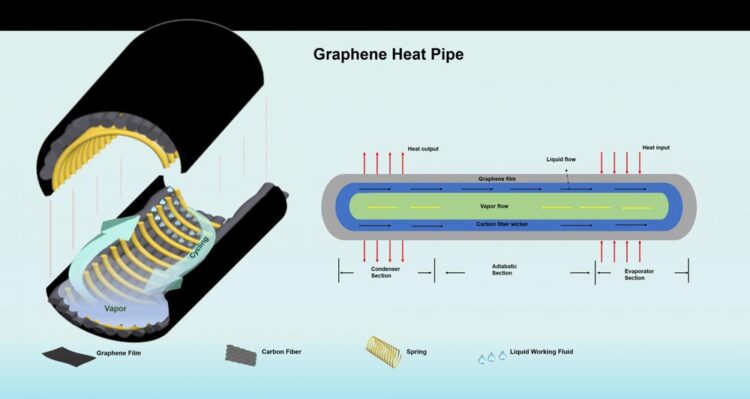Cooling electronics efficiently with graphene-enhanced heat pipes

Graphene enhanced heat pipes can efficiently cool power electronics
Credit: Ya Liu/Johan Liu/Chalmers University of Technology
Researchers at Chalmers University of Technology, Sweden, have found that graphene-based heat pipes can help solve the problems of cooling electronics and power systems used in avionics, data centres, and other power electronics.
“Heat pipes are one of the most efficient tools for this purpose, because of their high efficiency and unique ability to transfer heat over a large distance,” says Johan Liu, Professor of Electronics Production, at the Department of Microtechnology and Nanoscience at Chalmers.
The results, which also involved researchers in China and Italy, were recently published in the scientific Open Access journal Nano Select.
https:/
Electronics and data centres need to be efficiently cooled in order to work properly. Graphene enhanced heat pipes can solve these issues. Currently, heat pipes are usually made of copper, aluminium or their alloys. Due to the relatively high density and limited heat transmission capacity of these materials, heat pipes are facing severe challenges in future power devices and data centres.
Large data centres that deliver, for example, digital banking services and video streaming websites, are extremely energy-intensive, and an environmental culprit with greater emissions than the aviation industry. Reducing the climate footprint of this industry is therefore vital. The researchers’ discoveries here could make a significant energy efficiency contribution to these data centres, and in other applications too.
The graphene enhanced heat pipe exhibits a specific thermal transfer coefficient which is about 3.5 times better than that of copper-based heat pipe. The new findings pave the way for using graphene enhanced heat pipes in lightweight and large capacity cooling applications, as required in many applications such as avionics, automotive electronics, laptop computers, handsets, data centres as well as space electronics.
The graphene enhanced heat pipes are made of high thermal conductivity graphene assembled films assisted with carbon fibre wicker enhanced inner surfaces. The researchers tested pipes of 6mm outer diameter and 150mm length. They show great advantages and potential for cooling of a variety of electronics and power systems, especially where low weight and high corrosion resistance are required.
“The condenser section, the cold part of the graphene enhanced heat pipe, can be substituted by a heat sink or a fan to make the cooling even more efficient when applied in a real case,” explains Ya Liu, PhD Student at the Electronics Materials and Systems Laboratory at Chalmers.
###
The new study is based on a collaboration between researchers from Chalmers University of Technology, Fudan University, Shanghai University, China, SHT Smart High-Tech AB, Sweden and Marche Polytechnic University, Italy.
For further information, contact:
Ya Liu,
PhD Student,
Electronics Materials and Systems Laboratory (EMSL),
Department of Microtechnology and Nanoscience – MC2,
Chalmers University of Technology,
Gothenburg, Sweden,
yaliu@chalmers.se
Johan Liu,
Professor,
Electronics Materials and Systems Laboratory (EMSL),
Department of Microtechnology and Nanoscience – MC2,
Chalmers University of Technology,
Gothenburg, Sweden,
johan.liu@chalmers.se
Read the full paper in Nano Select:
A lightweight and high thermal performance graphene heat pipe
https:/
All latest news from the category: Power and Electrical Engineering
This topic covers issues related to energy generation, conversion, transportation and consumption and how the industry is addressing the challenge of energy efficiency in general.
innovations-report provides in-depth and informative reports and articles on subjects ranging from wind energy, fuel cell technology, solar energy, geothermal energy, petroleum, gas, nuclear engineering, alternative energy and energy efficiency to fusion, hydrogen and superconductor technologies.
Newest articles

Largest magnetic anisotropy of a molecule measured at BESSY II
At the Berlin synchrotron radiation source BESSY II, the largest magnetic anisotropy of a single molecule ever measured experimentally has been determined. The larger this anisotropy is, the better a…

Breaking boundaries: Researchers isolate quantum coherence in classical light systems
LSU quantum researchers uncover hidden quantum behaviors within classical light, which could make quantum technologies robust. Understanding the boundary between classical and quantum physics has long been a central question…

MRI-first strategy for prostate cancer detection proves to be safe
Active monitoring is a sufficiently safe option when prostate MRI findings are negative. There are several strategies for the early detection of prostate cancer. The first step is often a…



